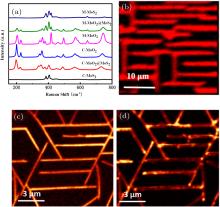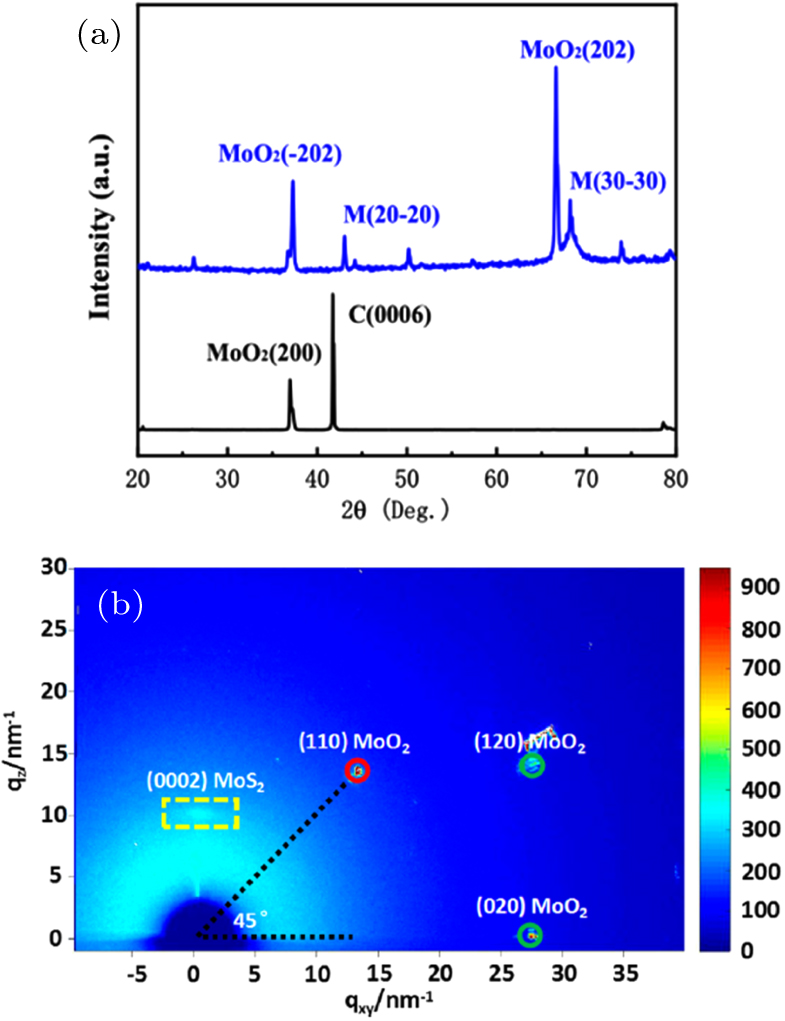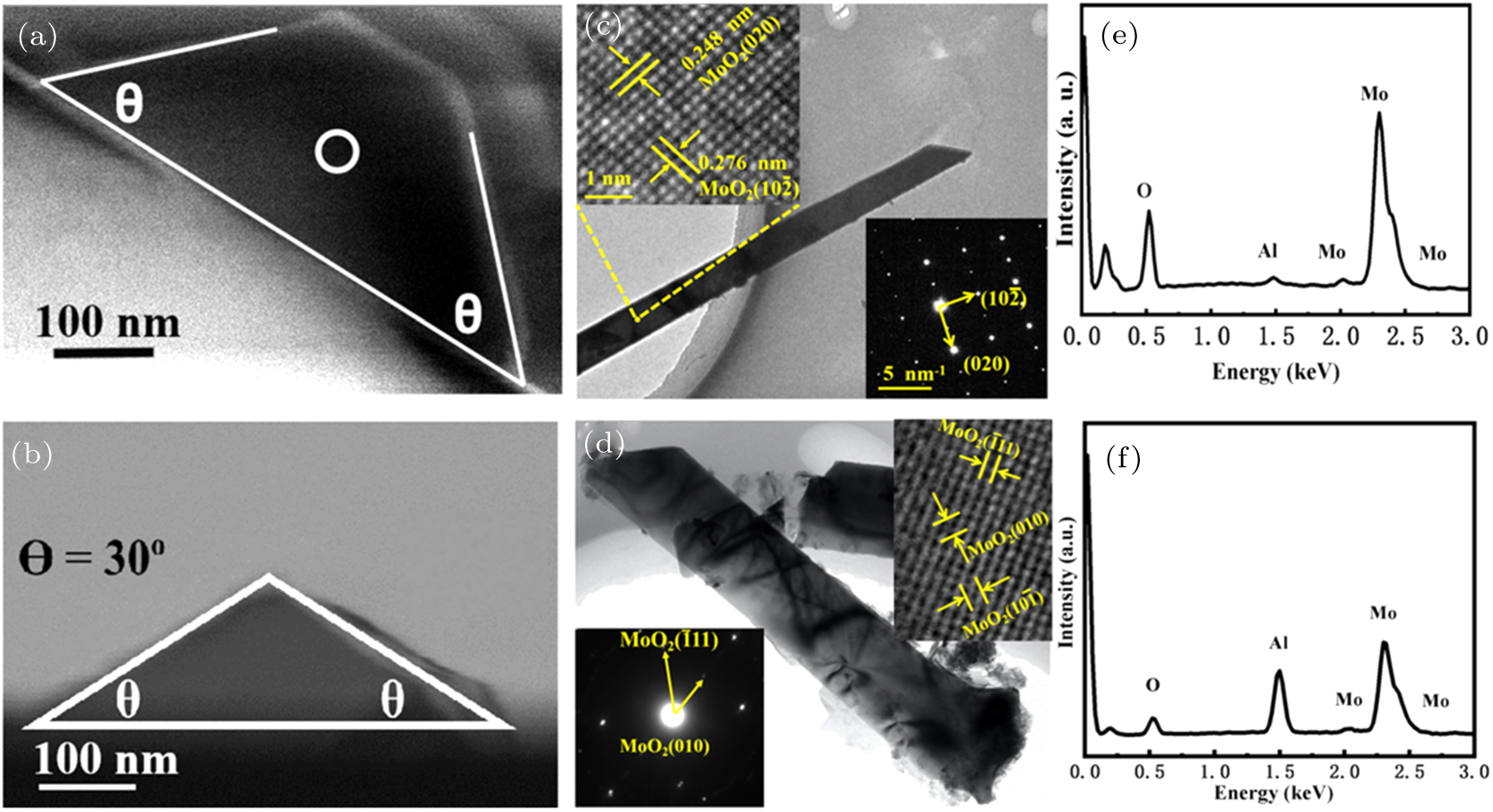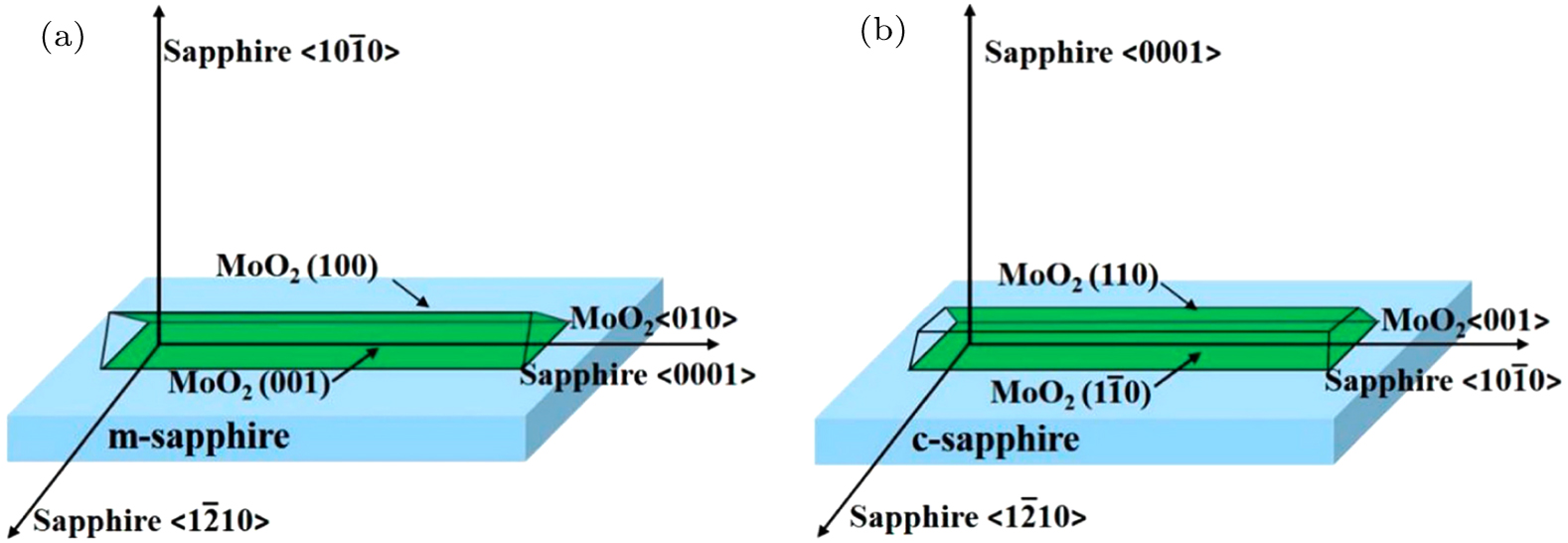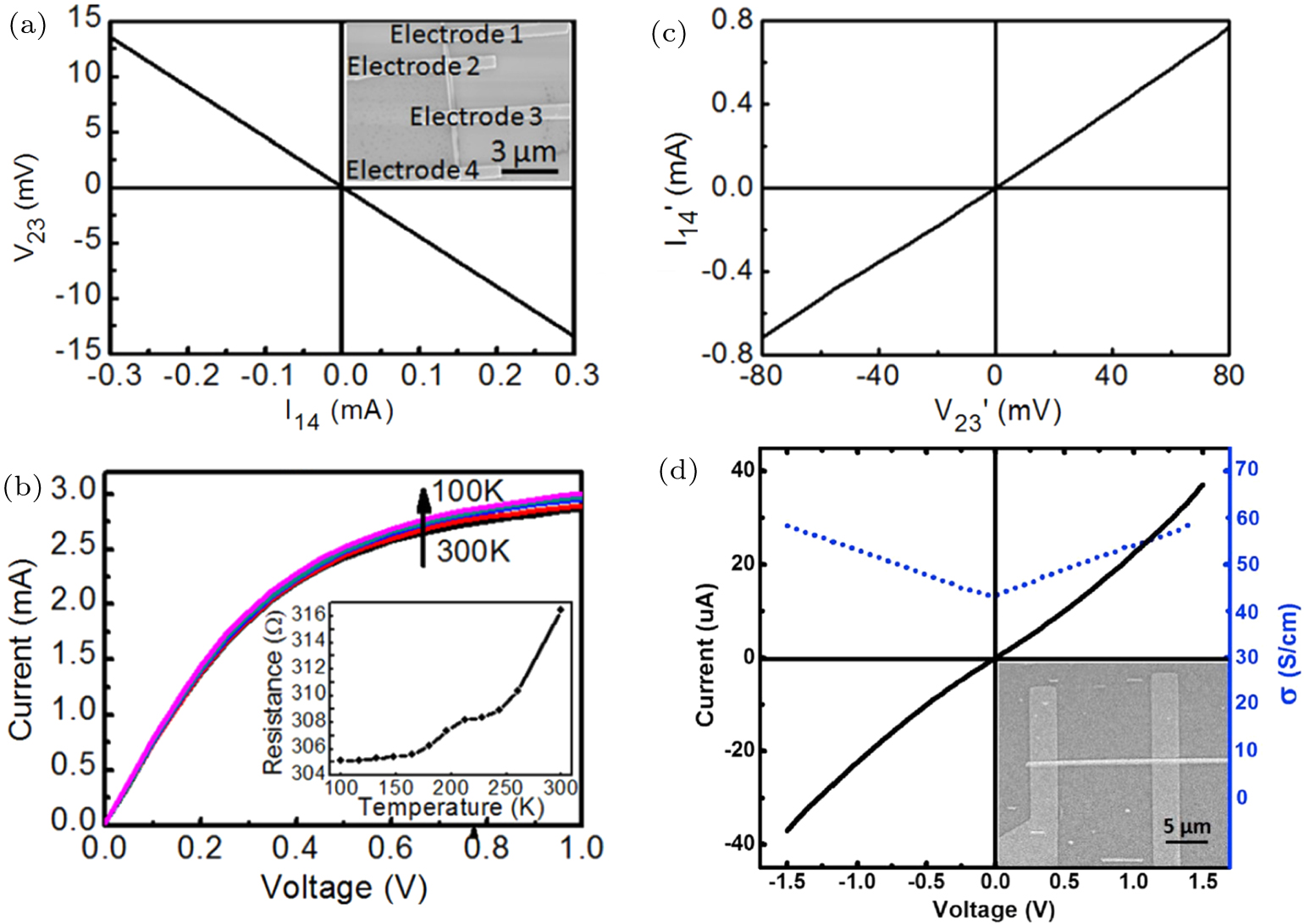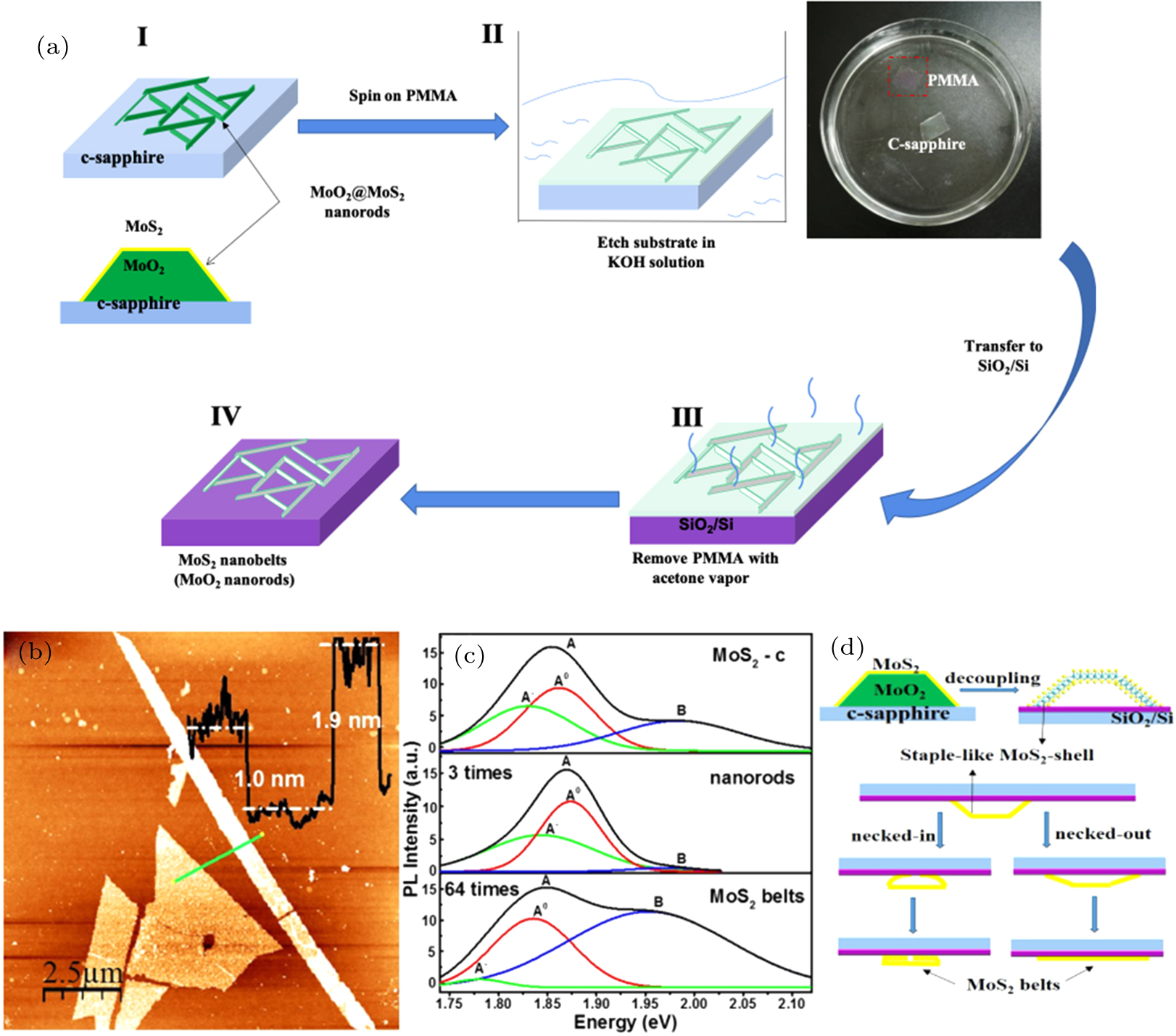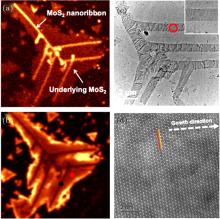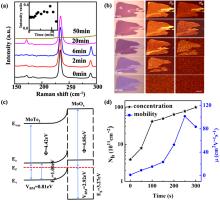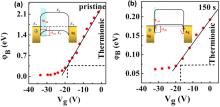中国物理B ›› 2020, Vol. 29 ›› Issue (11): 116802-.doi: 10.1088/1674-1056/abb310
Fengming Chen(陈凤鸣)1, Jinxin Liu(刘金鑫)1, Xiaoming Zheng(郑晓明)1, Longhui Liu(刘龙慧)1, Haipeng Xie(谢海鹏)1, Fei Song(宋飞)2, Yongli Gao(高永立)3,1, Han Huang(黄寒)1,†( )
)
-
收稿日期:2020-07-08修回日期:2020-08-10接受日期:2020-08-27出版日期:2020-11-05发布日期:2020-11-03
Interfaces between MoOx and MoX2 (X = S, Se, and Te)
Fengming Chen(陈凤鸣)1, Jinxin Liu(刘金鑫)1, Xiaoming Zheng(郑晓明)1, Longhui Liu(刘龙慧)1, Haipeng Xie(谢海鹏)1, Fei Song(宋飞)2, Yongli Gao(高永立)3,1, and Han Huang(黄寒)1, †
- 1 Hunan Key Laboratory of Super-microstructure and Ultrafast Process, School of Physics and Electronics, Central South University, Changsha 410083, China
2 Shanghai Synchrotron Radiation Facility, Shanghai Institute of Applied Physics, Chinese Academy of Sciences, Shanghai 201204, China
3 Department of Physics and Astronomy, University of Rochester, Rochester, NY 14627, USA
-
Received:2020-07-08Revised:2020-08-10Accepted:2020-08-27Online:2020-11-05Published:2020-11-03 -
Contact:†Corresponding author. E-mail:physhh@csu.edu.cn -
Supported by:the National Natural Science Foundation of China (Grant No. 11874427), the National Science Foundation DMR-1903962, and the Fundamental Research Funds for the Central Universities of Central South University (Grant No. 2019zzts429).
引用本文
Fengming Chen(陈凤鸣), Jinxin Liu(刘金鑫), Xiaoming Zheng(郑晓明), Longhui Liu(刘龙慧), Haipeng Xie(谢海鹏), Fei Song(宋飞), Yongli Gao(高永立), Han Huang(黄寒). [J]. 中国物理B, 2020, 29(11): 116802-.
Fengming Chen(陈凤鸣), Jinxin Liu(刘金鑫), Xiaoming Zheng(郑晓明), Longhui Liu(刘龙慧), Haipeng Xie(谢海鹏), Fei Song(宋飞), Yongli Gao(高永立), and Han Huang(黄寒). Interfaces between MoOx and MoX2 (X = S, Se, and Te)[J]. Chin. Phys. B, 2020, 29(11): 116802-.
| [1] |
Allen M J, Tung V C, Kaner R B 2010 Chem. Rev. 110 132 DOI: 10.1021/cr900070d
|
| [2] |
Kim K, Choi J Y, Kim T, Cho S H, Chung H J 2011 Nature 479 338 DOI: 10.1038/nature10680
|
| [3] |
Tan C, Cao X, Wu X J, He Q, Yang J, Zhang X, Chen J, Zhao W, Han S, Nam G H, Sindoro M, Zhang H 2017 Chem. Rev. 117 6225 DOI: 10.1021/acs.chemrev.6b00558
|
| [4] |
Xu M, Liang T, Shi M, Chen H 2013 Chem. Rev. 113 3766 DOI: 10.1021/cr300263a
|
| [5] |
Wang Q H, Kalantar-Zadeh K, Kis A, Coleman J N, Strano M S 2012 Nat. Nanotechnol. 7 699 DOI: 10.1038/nnano.2012.193
|
| [6] |
Luo F, Fan Y, Peng G, Xu S, Yang Y, Yuan K, Liu J, Ma W, Xu W, Zhu Z H 2019 ACS Photonics 6 2117 DOI: 10.1021/acsphotonics.9b00667
|
| [7] |
Geim A K 2009 Science 324 1530 DOI: 10.1126/science.1158877
|
| [8] |
Novoselov K S, Jiang D, Schedin F, Booth T, Khotkevich V, Morozov S, Geim A K 2005 Proc. Natl. Acad. Sci. USA 102 10451 DOI: 10.1073/pnas.0502848102
|
| [9] |
Jo I, Pettes M T, Kim J, Watanabe K, Taniguchi T, Yao Z, Shi L 2013 Nano Lett. 13 550 DOI: 10.1021/nl304060g
|
| [10] |
Akinwande D, Petrone N, Hone J 2014 Nat. Commun. 5 3586 DOI: 10.1038/ncomms4586
|
| [11] |
Manzeli S, Ovchinnikov D, Pasquier D, Yazyev O V, Kis A 2017 Nat. Rev. Mater. 2 17033 DOI: 10.1038/natrevmats.2017.33
|
| [12] |
Jariwala D, Sangwan V K, Lauhon L J, Marks T J, Hersam M C 2014 ACS Nano 8 1102 DOI: 10.1021/nn500064s
|
| [13] |
Koenig S P, Doganov R A, Schmidt H, Castro Neto A, Özyilmaz B 2014 Appl. Phys. Lett. 104 103106 DOI: 10.1063/1.4868132
|
| [14] |
Castellanos-Gomez A, Vicarelli L, Prada E, Island J O, Narasimha-Acharya K, Blanter S I, Groenendijk D J, Buscema M, Steele G A, Alvarez J 2014 2D Mater. 1 025001 DOI: 10.1088/2053-1583/1/2/025001
|
| [15] |
Liu H, Du Y, Deng Y, Peide D Y 2015 Chem. Soc. Rev. 44 2732 DOI: 10.1039/C4CS00257A
|
| [16] |
Drummond N, Zolyomi V, Fal’Ko V 2012 Phys. Rev. B 85 075423 DOI: 10.1103/PhysRevB.85.075423
|
| [17] |
Tao L, Cinquanta E, Chiappe D, Grazianetti C, Fanciulli M, Dubey M, Molle A, Akinwande D 2015 Nat. Nanotechnol. 10 227 DOI: 10.1038/nnano.2014.325
|
| [18] |
Ni Z, Liu Q, Tang K, Zheng J, Zhou J, Qin R, Gao Z, Yu D, Lu J 2012 Nano Lett. 12 113 DOI: 10.1021/nl203065e
|
| [19] |
Dávila M, Xian L, Cahangirov S, Rubio A, Le Lay G 2014 New J. Phys. 16 095002 DOI: 10.1088/1367-2630/16/9/095002
|
| [20] |
Wang H, Yu L, Lee Y H, Shi Y, Hsu A, Chin M L, Li L J, Dubey M, Kong J, Palacios T 2012 Nano Lett. 12 4674 DOI: 10.1021/nl302015v
|
| [21] |
Liu G B, Xiao D, Yao Y, Xu X, Yao W 2015 Chem. Soc. Rev. 44 2643 DOI: 10.1039/C4CS00301B
|
| [22] |
Jiang J, Hu W, Xie D, Yang J, He J, Gao Y, Wan Q 2019 Nanoscale 11 1360 DOI: 10.1039/C8NR07133K
|
| [23] |
Ji Q, Zhang Y, Zhang Y, Liu Z 2015 Chem. Soc. Rev. 44 2587 DOI: 10.1039/C4CS00258J
|
| [24] |
Pu J, Yomogida Y, Liu K K, Li L J, Iwasa Y, Takenobu T 2012 Nano Lett. 12 4013 DOI: 10.1021/nl301335q
|
| [25] |
Yin Z, Li H, Li H, Jiang L, Shi Y, Sun Y, Lu G, Zhang Q, Chen X, Zhang H 2011 ACS Nano 6 74 DOI: 10.1021/nn2024557
|
| [26] |
Zhang W, Huang J K, Chen C H, Chang Y H, Cheng Y J, Li L J 2013 Adv. Mater. 25 3456 DOI: 10.1002/adma.v25.25
|
| [27] |
Roy K, Padmanabhan M, Goswami S, Sai T P, Ramalingam G, Raghavan S, Ghosh A 2013 Nat. Nanotechnol. 8 826 DOI: 10.1038/nnano.2013.206
|
| [28] |
Yu L, Lee Y H, Ling X, Santos E J, Shin Y C, Lin Y, Dubey M, Kaxiras E, Kong J, Wang H 2014 Nano Lett. 14 3055 DOI: 10.1021/nl404795z
|
| [29] |
Lee G H, Yu Y J, Cui X, Petrone N, Lee C H, Choi M S, Lee D Y, Lee C, Yoo W J, Watanabe K 2013 ACS Nano 7 7931 DOI: 10.1021/nn402954e
|
| [30] |
Baugher B W, Churchill H O, Yang Y, Jarillo-Herrero P 2013 Nano Lett. 13 4212 DOI: 10.1021/nl401916s
|
| [31] |
Schmidt H, Wang S, Chu L, Toh M, Kumar R, Zhao W, Neto A H, Martin J, Adam S, Özyilmaz B, Eda G 2014 Nano Lett. 14 1909 DOI: 10.1021/nl4046922
|
| [32] |
Han W, Liu K, Yang S, Wang F, Su J, Jin B, Li H, Zhai T 2019 Sci. China Chem. 62 1300 DOI: 10.1007/s11426-019-9525-y
|
| [33] |
Cai Z, Liu B, Zou X, Cheng H-M 2018 Chem. Rev. 118 6091 DOI: 10.1021/acs.chemrev.7b00536
|
| [34] |
Wang Q, Lei Y, Wang Y, Liu Y, Song C, Zeng J, Song Y, Duan X, Wang D, Li Y 2020 Energy Environ. Sci. 13 1593 DOI: 10.1039/D0EE00450B
|
| [35] |
Fang L, Chen H, Yuan X, Huang H, Chen G, Li L, Ding J, He J, Tao S 2019 Nanoscale Res. Lett. 14 274 DOI: 10.1186/s11671-019-3110-z
|
| [36] |
Jiang J, Li N, Zou J, Zhou X, Eda G, Zhang Q, Zhang H, Li L-J, Zhai T, Wee A T 2019 Chem. Soc. Rev. 48 4639 DOI: 10.1039/C9CS00348G
|
| [37] |
Fang L, Yuan X, Liu K, Li L, Zhou P, Ma W, Huang H, He J, Tao S 2020 Nanoscale 12 3715 DOI: 10.1039/C9NR09874G
|
| [38] |
Dong R, Zhang T, Feng X 2018 Chem. Rev. 118 6189 DOI: 10.1021/acs.chemrev.8b00056
|
| [39] |
Zhou J, Lin J, Huang X, Zhou Y, Chen Y, Xia J, Wang H, Xie Y, Yu H, Lei J 2018 Nature 556 355 DOI: 10.1038/s41586-018-0008-3
|
| [40] |
Kang K, Xie S, Huang L, Han Y, Huang P Y, Mak K F, Kim C J, Muller D, Park J 2015 Nature 520 656 DOI: 10.1038/nature14417
|
| [41] |
Tongay S, Fan W, Kang J, Park J, Koldemir U, Suh J, Narang D S, Liu K, Ji J, Li J 2014 Nano Lett. 14 3185 DOI: 10.1021/nl500515q
|
| [42] |
Gong Y, Lei S, Ye G, Li B, He Y, Keyshar K, Zhang X, Wang Q, Lou J, Liu Z 2015 Nano Lett. 15 6135 DOI: 10.1021/acs.nanolett.5b02423
|
| [43] |
Ouyang F, Yang Z, Ni X, Wu N, Chen Y, Xiong X 2014 Appl. Phys. Lett. 104 071901 DOI: 10.1063/1.4865902
|
| [44] |
Kosynkin D V, Higginbotham A L, Sinitskii A, Lomeda J R, Dimiev A, Price B K, Tour J M 2009 Nature 458 872 DOI: 10.1038/nature07872
|
| [45] |
Jiao L, Zhang L, Wang X, Diankov G, Dai H 2009 Nature 458 877 DOI: 10.1038/nature07919
|
| [46] |
Li S, Lin Y C, Zhao W, Wu J, Wang Z, Hu Z, Shen Y, Tang D M, Wang J, Zhang Q 2018 Nat. Mater. 17 535 DOI: 10.1038/s41563-018-0055-z
|
| [47] |
Zhou D, Li H, Si N, Jiang Y, Huang H, Li H, Niu T 2020 Appl. Phys. Lett. 116 061602 DOI: 10.1063/1.5140376
|
| [48] |
Chen Y, Sun J, Qiu W, Wang X, Liu W, Huang Y, Dai G, Yang J, Gao Y 2019 Appl. Phys. A 125 691 DOI: 10.1007/s00339-019-2997-7
|
| [49] |
Kang L, Chen H, Yang Z J, Yuan Y, Huang H, Yang B, Gao Y, Zhou C 2018 J. Appl. Phys. 123 205110 DOI: 10.1063/1.5027541
|
| [50] |
Li X, Wang X, Zhang L, Lee S, Dai H 2008 Science 319 1229 DOI: 10.1126/science.1150878
|
| [51] |
Terrones M 2009 Nature 458 845 DOI: 10.1038/458845a
|
| [52] |
Cai J, Ruffieux P, Jaafar R, Bieri M, Braun T, Blankenburg S, Muoth M, Seitsonen A P, Saleh M, Feng X 2010 Nature 466 470 DOI: 10.1038/nature09211
|
| [53] |
Ruffieux P, Wang S, Yang B, Sánchez-Sánchez C, Liu J, Dienel T, Talirz L, Shinde P, Pignedoli C A, Passerone D 2016 Nature 531 489 DOI: 10.1038/nature17151
|
| [54] |
Tian G, Shen Y, He B, Yu Z, Song F, Lu Y, Wang P, Gao Y, Huang H 2017 Surf. Sci. 665 89 DOI: 10.1016/j.susc.2017.08.008
|
| [55] |
He B, Tian G, Gou J, Liu B, Shen K, Tian Q, Yu Z, Song F, Xie H, Gao Y 2019 Surf. Sci. 679 147 DOI: 10.1016/j.susc.2018.09.005
|
| [56] |
Tian Q, He B, Zhao Y, Wang S, Xiao J, Song F, Wang Y, Lu Y, Xie H, Huang H 2019 Synth. Met. 251 24 DOI: 10.1016/j.synthmet.2019.03.016
|
| [57] |
Xu G, Wang X, Sun Y, Chen X, Zheng J, Sun L, Jiao L, Li J 2015 Nano Res. 8 2946 DOI: 10.1007/s12274-015-0799-6
|
| [58] |
Botello-Méndez A R, Lopez-Urias F, Terrones M, Terrones H 2009 Nanotechnology 20 325703 DOI: 10.1088/0957-4484/20/32/325703
|
| [59] |
Cai Y, Zhang G, Zhang Y W 2014 J. Am. Chem. Soc. 136 6269 DOI: 10.1021/ja4109787
|
| [60] |
Mak K F, He K, Shan J, Heinz T F 2012 Nat. Nanotechnol. 7 494 DOI: 10.1038/nnano.2012.96
|
| [61] |
Meyer J, Kidambi P R, Bayer B C, Weijtens C, Kuhn A, Centeno A, Pesquera A, Zurutuza A, Robertson J, Hofmann S 2014 Sci. Rep. 4 5380 DOI: 10.1038/srep05380
|
| [62] |
Huang J, Xu Z, Yang Y 2007 Adv. Funct. Mater. 17 1966 DOI: 10.1002/adfm.v17:12
|
| [63] |
Lin J D, Han C, Wang F, Wang R, Xiang D, Qin S, Zhang X-A, Wang L, Zhang H, Wee A T S 2014 ACS Nano 8 5323 DOI: 10.1021/nn501580c
|
| [64] |
Lei B, Hu Z, Xiang D, Wang J, Eda G, Han C, Chen W 2017 Nano Res. 10 1282 DOI: 10.1007/s12274-016-1386-1
|
| [65] |
Xiang D, Han C, Wu J, Zhong S, Liu Y, Lin J, Zhang X A, Hu W P, Ozyilmaz B, Neto A C 2015 Nat. Commun. 6 6485 DOI: 10.1038/ncomms7485
|
| [66] |
Lou Y H, Xu M F, Zhang L, Wang Z K, Naka S, Okada H, Liao L S 2013 Org. Electron. 14 2698 DOI: 10.1016/j.orgel.2013.07.017
|
| [67] |
Gwinner M C, Pietro R D, Vaynzof Y, Greenberg K J, Ho P K, Friend R H, Sirringhaus H 2011 Adv. Funct. Mater. 21 1432 DOI: 10.1002/adfm.v21.8
|
| [68] |
Liu X, Wang C, Yi S, Gao Y 2014 Org. Electron. 15 977 DOI: 10.1016/j.orgel.2014.02.011
|
| [69] |
Zhang M, Irfan Ding H, Gao Y, Tang C W 2010 Appl. Phys. Lett. 96 183301 DOI: 10.1063/1.3415497
|
| [70] |
Wang C, Irfan I, Gao Y 2014 Appl. Phys. Lett. 105 181602 DOI: 10.1063/1.4901164
|
| [71] |
Gao Y 2010 Mater. Sci. Eng. R Rep. 68 39 DOI: 10.1016/j.mser.2010.01.001
|
| [72] |
Wang C, Irfan I, Liu X, Gao Y 2014 J. Vac. Sci. Technol. B 32 040801 DOI: 10.1116/1.4886364
|
| [73] |
Irfan I, James Turinske A, Bao Z, Gao Y 2012 Appl. Phys. Lett. 101 093305 DOI: 10.1063/1.4748978
|
| [74] |
Choi S, Fuentes-Hernandez C, Wang C-Y, Khan T M, Larrain F A, Zhang Y, Barlow S, Marder S R, Kippelen B 2016 ACS Appl. Mater. Interfaces 8 24744 DOI: 10.1021/acsami.6b07029
|
| [75] |
Zhou C, Zhao Y, Raju S, Wang Y, Lin Z, Chan M, Chai Y 2016 Adv. Funct. Mater. 26 4223 DOI: 10.1002/adfm.v26.23
|
| [76] |
Meyer J, Hamwi S, Kröger M, Kowalsky W, Riedl T, Kahn A 2012 Adv. Mater. 24 5408 DOI: 10.1002/adma.v24.40
|
| [77] |
Ho P H, Chang Y R, Chu Y C, Li M K, Tsai C A, Wang W H, Ho C H, Chen C W, Chiu P W 2017 ACS Nano 11 7362 DOI: 10.1021/acsnano.7b03531
|
| [78] |
Yamamoto M, Dutta S, Aikawa S, Nakaharai S, Wakabayashi K, Fuhrer M S, Ueno K, Tsukagoshi K 2015 Nano Lett. 15 2067 DOI: 10.1021/nl5049753
|
| [79] |
Wu D, Yang Y, Zhu P, Zheng X, Chen X, Shi J, Song F, Gao X, Zhang X, Ouyang F, Xiong X, Gao Y, Huang H 2018 J. Phys. Chem. C 122 1860 DOI: 10.1021/acs.jpcc.7b10666
|
| [80] |
Liu J, Shi J, Wu D, Zheng X, Chen F, Xiao J, Li Y, Song F, Gao Y, Huang H 2020 Curr. Appl. Phys. 20 1130 DOI: 10.1016/j.cap.2020.07.015
|
| [81] |
Xie Q, Zheng X, Wu D, Chen X, Shi J, Han X, Zhang X, Peng G, Gao Y, Huang H 2017 Appl. Phys. Lett. 111 093505 DOI: 10.1063/1.5001183
|
| [82] |
Shi J, Wu D, Zheng X, Xie D, Song F, Zhang X, Jiang J, Yuan X, Gao Y, Huang H 2018 Phys. Status Solidi (B) 255 1800254 DOI: 10.1002/pssb.v255.9
|
| [83] |
Wu D, Shi J, Zheng X, Liu J, Dou W, Gao Y, Yuan X, Ouyang F, Huang H 2019 Phys Status Solidi Rapid Res Lett 13 1900063 DOI: 10.1002/pssr.v13.7
|
| [84] |
Zheng X, Wei Y, Deng C, Huang H, Yu Y, Wang G, Peng G, Zhu Z, Zhang Y, Jiang T, Qin S, Zhang R, Zhang X 2018 ACS Appl. Mater. Interfaces 10 30045 DOI: 10.1021/acsami.8b11003
|
| [85] |
Zheng X, Wei Y, Liu J, Wang S, Shi J, Yang H, Peng G, Deng C, Luo W, Zhao Y, Li Y, Sun K, Wan W, Xie H, Gao Y, Zhang X, Huang H 2019 Nanoscale 11 13469 DOI: 10.1039/C9NR04212A
|
| [86] |
Zheng X, Zhang X, Wei Y, Liu J, Yang H, Zhang X, Wang S, Xie H, Deng C, Gao Y 2020 Nano Res. 13 952 DOI: 10.1007/s12274-020-2724-x
|
| [87] |
Xie H, Huang H, Cao N, Zhou C, Niu D, Gao Y 2015 Physica B 477 14 DOI: 10.1016/j.physb.2015.07.032
|
| [88] |
Sun H, Liang Z, Shen K, Hu J, Ji G, Li Z, Li H, Zhu Z, Li J, Gao X 2017 Surf. Sci. 661 34 DOI: 10.1016/j.susc.2017.03.003
|
| [89] |
Kumar P, Singh M, Sharma R K, Reddy G 2016 Mater. Res. Express 3 055021 DOI: 10.1088/2053-1591/3/5/055021
|
| [90] |
Kumar P, Singh M, Reddy G 2017 Mater. Res. Express 4 036405 DOI: 10.1088/2053-1591/aa62ce
|
| [91] |
Qian F, Gradecak S, Li Y, Wen C-Y, Lieber C M 2005 Nano Lett. 5 2287 DOI: 10.1021/nl051689e
|
| [92] |
Mariani G, Zhou Z, Scofield A, Huffaker D L 2013 Nano Lett. 13 1632 DOI: 10.1021/nl400083g
|
| [93] |
Chen G, Ågren H, Ohulchanskyy T Y, Prasad P N 2015 Chem. Soc. Rev. 44 1680 DOI: 10.1039/C4CS00170B
|
| [94] |
Zheng L, Xu Y, Jin D, Xie Y 2010 J. Mater. Chem. 20 7135 DOI: 10.1039/C0JM00744G
|
| [95] |
Liu J, Zhang Z, Pan C, Zhao Y, Su X, Zhou Y, Yu D 2004 Mater. Lett. 58 3812 DOI: 10.1016/j.matlet.2004.07.034
|
| [96] |
Vorobeva N S, Lipatov A, Muratov D S, Sinitskii A 2018 Nanotechnology 29 505707 DOI: 10.1088/1361-6528/aae366
|
| [97] |
Ma Y R, Tsai C C, Lee S F, Cheng K W, Liou Y, Der Yao Y 2006 J. Magn. Magn. Mater. 304 e13 DOI: 10.1016/j.jmmm.2006.02.025
|
| [98] |
Yang T H, Aggarwal R, Gupta A, Zhou H, Narayan R J, Narayan J 2010 J. Appl. Phys. 107 053514 DOI: 10.1063/1.3327241
|
| [99] |
Zhang F, Saito K, Tanaka T, Nishio M, Guo Q 2014 J. Cryst. Growth 387 96 DOI: 10.1016/j.jcrysgro.2013.11.022
|
| [100] |
Zhao Y, Hwan Lee J, Zhu Y, Nazari M, Chen C, Wang H, Bernussi A, Holtz M, Fan Z 2012 J. Appl. Phys. 111 053533 DOI: 10.1063/1.3692391
|
| [101] |
Baker T J, Haskell B A, Wu F, Speck J S, Nakamura S 2006 Jpn. J. Appl. Phys. 45 L154 DOI: 10.1143/JJAP.45.L154
|
| [102] |
Scheuschner N, Gillen R, Staiger M, Maultzsch J 2015 Phys. Rev. B 91 235409 DOI: 10.1103/PhysRevB.91.235409
|
| [103] |
Wang S, Rong Y, Fan Y, Pacios M, Bhaskaran H, He K, Warner J H 2014 Chem. Mater. 26 6371 DOI: 10.1021/cm5025662
|
| [104] |
Hao S, Yang B, Gao Y 2017 Physica Status Solidi (B) 254 1600245 DOI: 10.1002/pssb.201600245
|
| [105] |
Kumari L, Ma Y R, Tsai C C, Lin Y W, Wu S Y, Cheng K W, Liou Y 2007 Nanotechnology 18 115717 DOI: 10.1088/0957-4484/18/11/115717
|
| [106] |
Spevack P, McIntyre N 1992 J. Phys. Chem. 96 9029 DOI: 10.1021/j100201a062
|
| [107] |
Dieterle M, Weinberg G, Mestl G 2002 Phys. Chem. Chem. Phys. 4 812 DOI: 10.1039/b107012f
|
| [108] |
Wang X, Feng H, Wu Y, Jiao L 2013 J. Am. Chem. Soc. 135 5304 DOI: 10.1021/ja4013485
|
| [109] |
Mukundan S, Mohan L, Chandan G, Roul B, Krupanidhi S 2014 J. Appl. Phys. 116 204502 DOI: 10.1063/1.4902892
|
| [110] |
Pu E, Liu D, Ren P, Zhou W, Tang D, Xiang B, Wang Y, Miao J 2017 AIP Adv. 7 025015 DOI: 10.1063/1.4977543
|
| [111] |
Bhosle V, Tiwari A, Narayan J 2005 J. Appl. Phys. 97 083539 DOI: 10.1063/1.1868852
|
| [112] |
Hu B, Mai L, Chen W, Yang F 2009 Acs Nano 3 478 DOI: 10.1021/nn800844h
|
| [113] |
Ahn E, Seo Y S, Cho J, Lee I, Hwang J, Jeen H 2016 RSC Adv. 6 60704 DOI: 10.1039/C6RA09928A
|
| [114] |
Dahl-Petersen C, Šarić M, Brorson M, Moses P G, Rossmeisl J, Lauritsen J V, Helveg S 2018 ACS Nano 12 5351 DOI: 10.1021/acsnano.8b00125
|
| [115] |
Kumar P, Singh M, Sharma R K, Reddy G 2016 Mater. Chem. Phys. 178 6 DOI: 10.1016/j.matchemphys.2016.03.036
|
| [116] |
Van Der Zande A M, Huang P Y, Chenet D A, Berkelbach T C, You Y, Lee G H, Heinz T F, Reichman D R, Muller D A, Hone J C 2013 Nat. Mater. 12 554 DOI: 10.1038/nmat3633
|
| [117] |
Li M Y, Shi Y, Cheng C C, Lu L S, Lin Y C, Tang H L, Tsai M L, Chu C W, Wei K H, He J H 2015 Science 349 524 DOI: 10.1126/science.aab4097
|
| [118] |
Endo R, Maeda S, Jinnai Y, Lan R, Kuwahara M, Kobayashi Y, Susa M 2010 Jpn. J. Appl. Phys. 49 065802 DOI: 10.1143/JJAP.49.065802
|
| [119] |
Dai H, Rath A, Hearn Y S, Pennycook S J, Chua D H 2018 J. Phys. Chem. Lett. 9 7185 DOI: 10.1021/acs.jpclett.8b03437
|
| [120] |
Ebbesen T, Lezec H, Hiura H, Bennett J, Ghaemi H, Thio T 1996 Nature 382 54 DOI: 10.1038/382054a0
|
| [121] |
Ren X, Qi X, Shen Y, Xiao S, Xu G, Zhang Z, Huang Z, Zhong J 2016 J Phy D: Appl Phys 49 315304 DOI: 10.1088/0022-3727/49/31/315304
|
| [122] |
Ayari A, Cobas E, Ogundadegbe O, Fuhrer M S 2007 J. Appl. Phys. 101 014507 DOI: 10.1063/1.2407388
|
| [123] |
Conley H J, Wang B, Ziegler J I, Haglund Jr R F, Pantelides S T, Bolotin K I 2013 Nano Lett. 13 3626 DOI: 10.1021/nl4014748
|
| [124] |
Mak K F, Lee C, Hone J, Shan J, Heinz T F 2010 Phys. Rev. Lett. 105 136805 DOI: 10.1103/PhysRevLett.105.136805
|
| [125] |
Mak K F, Shan J 2016 Nat. Photonics 10 216 DOI: 10.1038/nphoton.2015.282
|
| [126] |
Eftekhari A 2017 J. Mater. Chem. A 5 18299 DOI: 10.1039/C7TA04268J
|
| [127] |
Yu Z L, Zhao Y Q, Liu B, Yang J L, Cai M Q 2020 J. Phys. Condens. Matter 32 115703 DOI: 10.1088/1361-648X/ab5b3d
|
| [128] |
Qian M Y, Yu Z L, Wan Q, He P B, Liu B, Yang J L, Xu C M, Cai M Q 2020 Phys. Status Solidi Rapid Res. Lett. 14 2000016 DOI: 10.1002/pssr.v14.7
|
| [129] |
Wu J, Li H, Yin Z, Li H, Liu J, Cao X, Zhang Q, Zhang H 2013 Small 9 3314 DOI: 10.1002/smll.201301542
|
| [130] |
Das T, Seo D, Seo J E, Chang J 2020 Adv. Electron. Mater. 6 2000008 DOI: 10.1002/aelm.v6.5
|
| [131] |
Hoffman A N, Gu Y, Tokash J, Woodward J, Xiao K, Rack P D 2020 ACS Appl. Mater. Interfaces 12 7345 DOI: 10.1021/acsami.9b21287
|
| [132] |
Lezama I G, Arora A, Ubaldini A, Barreteau C, Giannini E, Potemski M, Morpurgo A F 2015 Nano Lett. 15 2336 DOI: 10.1021/nl5045007
|
| [133] |
Yamamoto M, Wang S T, Ni M, Lin Y F, Li S L, Aikawa S, Jian W B, Ueno K, Wakabayashi K, Tsukagoshi K 2014 ACS Nano 8 3895 DOI: 10.1021/nn5007607
|
| [134] |
Das S, Chen H Y, Penumatcha A V, Appenzeller J 2013 Nano Lett. 13 100 DOI: 10.1021/nl303583v
|
| [135] |
Liu J, Liu X, Chen Z, Liu Y, Li J 2019 Nano Res. 12 463 DOI: 10.1007/s12274-018-2243-1
|
| [136] |
Sze S M, Ng K K 2006 Physics of semiconductor devices John wiley & sons
|
| [137] |
Liu Y, Cai Y, Zhang G, Zhang Y W, Ang K W 2017 Adv. Funct. Mater. 27 1604638 DOI: 10.1002/adfm.v27.7
|
| [138] |
Xia J, Huang X, Liu L Z, Wang M, Wang L, Huang B, Zhu D D, Li J J, Gu C Z, Meng X M 2014 Nanoscale 6 8949 DOI: 10.1039/C4NR02311K
|
| No related articles found! |
|
||




